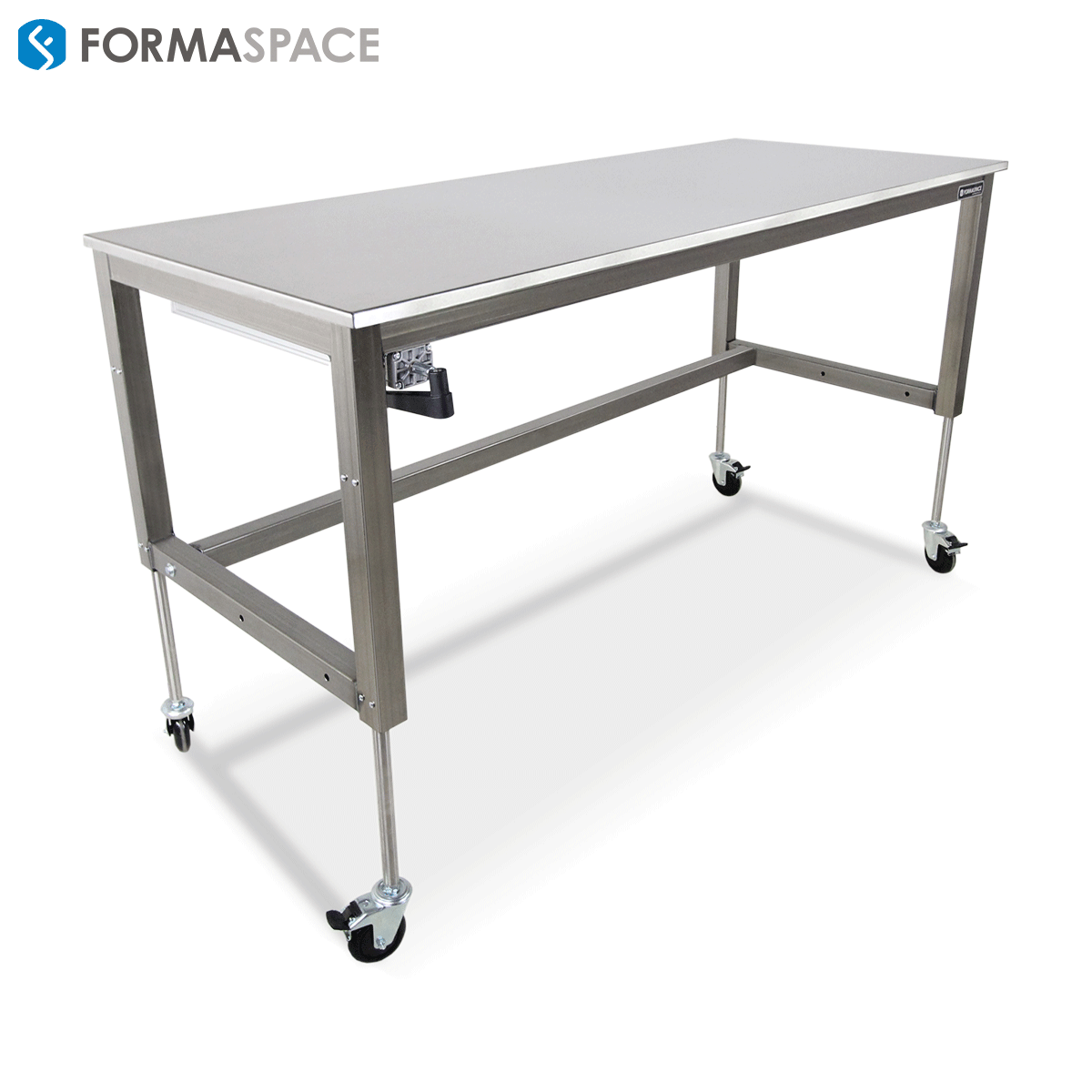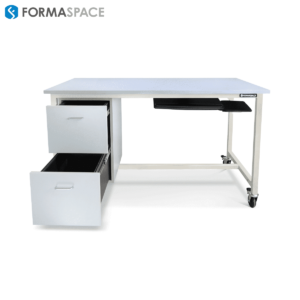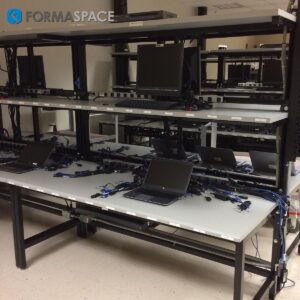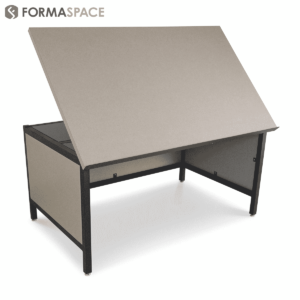If we could travel in time, it would be fascinating to bring an office worker from the year 1916 to come visit the modern day office of 2016.
Certainly, our visitor from the past would be struck by the bright quality of the lighting, featuring the new low energy LED lighting systems. They’d take note that even two story buildings have elevators and would marvel in wonder at the clean lines of today’s classic Parsons desk. But above all they would be captivated by all our electronic gadgets–from flat screen monitors, small notebook computers, to ubiquitous tablets and smartphones in our hands.
While there are still landline telephones on most office desks, we increasingly depend upon mobile devices to communicate at the office. Often times communication taking place through texting or groupware apps like Slackware. Even texting each other during meetings while in the same conference room. In a modern world where everything is accessible from your desk or from the mobile device in your hand, there’s less and less reason to stand up at your Parsons desk or rise from your rolling office chair.
That leads us to another observation that our visitor from 1916 would no doubt point out: we are increasingly suffering from an epidemic of obesity, type II diabetes and lower back pain.
Up to 80% of all adults will experience lower back pain.
In this Stanford University Medical Center video, Professor Sean Mackey MD discusses chronic low back pain and its causes and treatments.
According to Dr. Mackey, low back pain affects more than 100 million Americans (a larger number than heart disease, diabetes and cancer combined), with an economic impact totaling somewhere between $560 and $630 billion a year in medical expenses.
As devastating as the onset of lower back pain is, the American College of Physicians reports that 80% of patients can recover within four weeks and 90% within 12 weeks through self-treatment. The remaining 10% will ultimately develop chronic back pain that will require further treatment and pain management.
What can be done about preventing lower back pain in the office?
While the prognosis for recovering from back pain is good for the majority patients, it’s best to avoid it in the first place. With that being said what can be done to avoid back pain at the office?
Well, if we ask our office worker from 1916 how to avoid back pain, the answer would probably be “avoid lifting heavy objects the wrong way and twisting your back.” While this is certainly good advice and lifting from your knees good posture for her excellent ideas, the reality is there’s very little lifting performed by employees at today’s office workplaces. Even at industrial workplaces with production assembly lines, engineers have worked hard to keep lifting duties within proscribed safe ergonometric limits.
For the modern office worker, the source of back pain seems to fall in the opposite direction: we are simply too inactive during the day. Hours of sitting at desks are taking a toll on our spines.
Stanford Standing Desk Study “Impact of a Sit-Stand Workstation on Chronic Lower Back Pain Results of a Randomized Trial”
Earlier this year Stanford University researchers released a study called “Impact of a Sit-Stand Workstation on Chronic Lower Back Pain Results of a Randomized Trial” which was published in the JOEM (Journal of Occupational and Environmental Medicine). According to the study, office workers who participated using standing desks experienced less pain while working.
The idea behind the study was to determine if workers who changed their seating position back and forth to a standing position during the course of the day (a technique called ‘postural variation’) experienced any health benefits are not. In the study, over three quarters of the participants using the sit-stand workstations were more likely to report pain-free days than those in the control group working at regular sit-down workstations.
This effect took hold relatively quickly in the study; participants reported a difference in about 15 days.
Individuals who came into the study with lower back and neck pain reported a reduction in pain and consequently an increase in their ability to concentrate on work tasks when using the sit-stand desks.
Do standing desks provide a lower back pain health remedy or is it a myth?
It’s doubtful if the Stanford study will be the last word on the topic. Earlier this month, a Cochrane Study on “Workplace interventions for reducing sitting time at work” was published that reviewed 20 of the most recent scientific studies on sitting versus sitting/standing.
The popular media interpreted this study, stating claims that sitting is bad for you at the workplace (aka “sitting is the new smoking”) were invalid.
That’s not the case however.
It’s important to understand that the Cochrane study did not refute the possibility that sit-stand workstations are beneficial; rather it critiqued the persuasiveness of the evidence presented in these studies, most of which had very few participants and did not document long-term results.
More studies with larger groups of participants and long-term results are needed.
How do you make the transition from a Parsons desk to a standing desk?
In the video posted below, Nolan Peterson, Wellness Exercise Specialist at the Mayo Clinic, provides practical tips for making the transition from working full time at a sitting Parsons desk to a standing desk.
According to the Mayo Clinic, the key points are to begin by taking the transition easy. If Once you start feeling fatigued by standing, just take a break and sit back down. It’s that easy!
Second, it’s just as important to establish proper posture at a standing desk as it is at a normal sitting, Parsons desk. When you stand, your eyes should be level with the top of the computer monitor so that you can gaze down-wards to read it.
Third, pay attention to footwear. Wear sensible structured shoes and consider investing in a cushioned comfort floor pad (also known as an anti-fatigue mat).
In just a matter of weeks, you’ll feel as comfortable working at your standing desk as you will at your regular sitting desk.
Formaspace keeps you moving at work.
Struggling with lower back pain or have an office with low activity? Formaspace has your solution. We can create beautifully crafted sit/stand desks, as well as any other industrial grade furniture or work bench that makes a bold statement for your workplace. If you can imagine it, we can create it. Discover the full line of office furniture from Formaspace. Our strong, distinctive industrial grade furniture helps you make a powerful statement at work. To learn more, call us today on our dedicated customer line at 800-251-1505.
Trusted names like Apple Computer, Boeing, Dell, Eli Lilly, Exxon Mobile, Ford, General Electric, Intel, Lockheed Martin, Medtronic, NASA, Novartis, Stanford University, Toyota and more rely on Formaspace furniture for their office, technical, manufacturing and laboratory facilities. Why not call us today?








